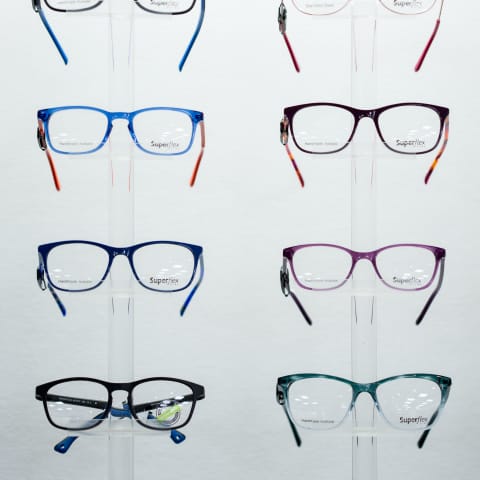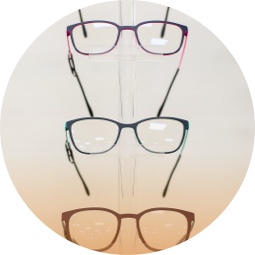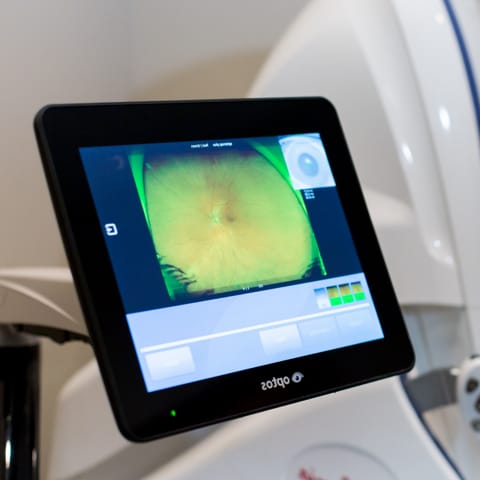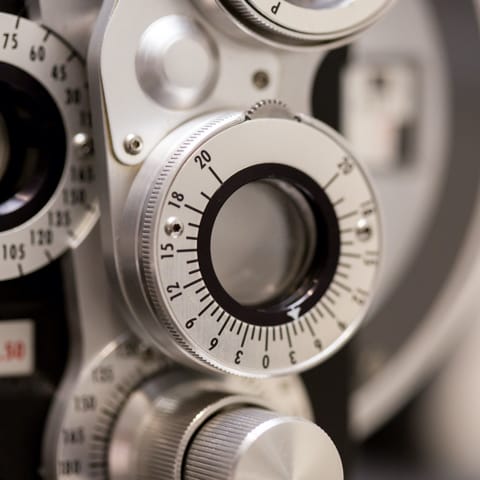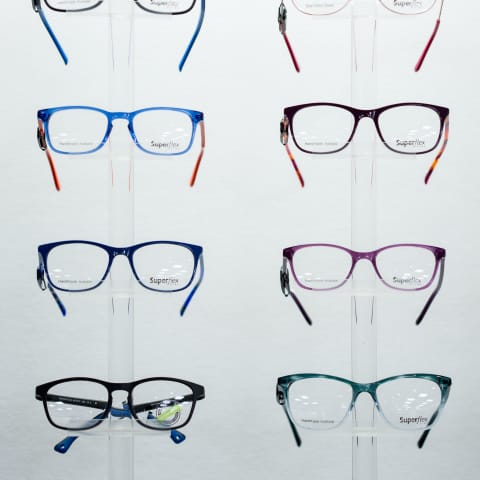Experience & Knowledge Can Save Your Sight
At Tutt Street Optometry, we’re always on the lookout for threats to your sight. Our comprehensive eye exams look for signs of various eye conditions and diseases before they show symptoms.
Our proactive approach helps detect diseases before they cause permanent damage to your sight. That’s why regular, comprehensive eye exams are so important. If we don’t see your eyes regularly, we can’t help you maintain your vision.
So please book an appointment today to diagnose and detect eye diseases before they cause harm.

Age-Related Macular Degeneration
Age-related macular degeneration (AMD) occurs when the macula begins to deteriorate with age. The macula is responsible for your vital central vision, the vision that helps your drive, read, and recognize faces.
AMD is the leading cause of blindness in adults in North America over the age of 55. It can present in 2 different forms:
Dry AMD
Dry AMD is the most common form of AMD, making up roughly 90% of all cases. When dry AMD advances, the light-sensitive cells around the macula begin to die. In these cases, patients may experience blind spots in their central vision or lose their central vision entirely.
Although wet AMD only presents in about 10% of cases, it is usually the more serious of the 2 forms. Wet AMD develops when abnormal blood vessels grow in front of and around the macula. These blood vessels can start to bleed, blurring and distorting the patient’s vision.
Symptoms of AMD
Some symptoms of AMD include:
- Straight lines appearing wavy
- Blurry or dark spots in your central vision
Protecting yourself from UV light exposure, quitting smoking, and ensuring good health and fitness may help prevent AMD.
Cataracts
Cataracts are the leading cause of blindness worldwide. They are a common condition that develops as people age and result from the hardening of the clear lens in your eye. As the lens hardens, it becomes opaque, obstructing vision.
Generally, cataracts develop without any pain. Slow or sudden development is possible. Living with this common condition is like driving with a dirty windshield, painless but frustrating and disorienting.
Symptoms of cataracts might include:
- Seeing muted or dull colours
- Sensitivity to light
- Decreased night vision
- Halos around lights
- Light sensitivity
While they are relatively normal, a good way to reduce your chances of cataracts and delay their onset is to protect your eyes from UV rays with sunglasses.
If you do get cataracts, your vision can often be corrected with glasses or contact lenses. But, if they are too advanced, surgery may be recommended.
Cataract surgery is safe and effective. The cloudy lens is removed from your eye and replaced with an artificial one, restoring vision.
Diabetic Eye Diseases
Those with diabetes are at risk for a variety of health conditions, including eye diseases. When faced with a health issue like diabetes, the eyes can be easily overlooked. But, it’s imperative to keep your ocular health under control. After all, diabetes is the leading cause of blindness in Canada.
By having an eye exam every year, your optometrist can screen for diabetic eye diseases and monitor their progression if you already have one. Even if your regular doctor checks your eyes, a dilated retinal exam can thoroughly explore the health and condition of your eyes.
Diabetic Retinopathy
Diabetic retinopathy occurs when sustained high blood sugar damages the small blood vessels in the retina. It is the most common cause of legal blindness in working-age people.
At first, there are little to no symptoms of the disease. But as it progresses, you may notice:
- Loss of central vision
- Black spots
- Holes in vision
Diabetic Macular Edema
People with diabetic retinopathy sometimes also experience a complication of the disease called diabetic macular edema. This disease occurs when the tiny blood vessels in the retina bulge and ooze fluid into the macula, the part of your eye responsible for central vision.
Diabetic macular edema is a serious condition that can drastically reduce your quality of life.
Glaucoma
Glaucoma is a group of eye diseases that damage the optic nerve and a major cause of blindness in older adults. While not present in every type of glaucoma, the disease is commonly characterized by high intraocular pressure. Glaucoma is a serious condition that can cause irreversible vision loss and blindness.
2 Main Types of Glaucoma
The 2 main types of glaucoma are open-angle glaucoma and angle-closure glaucoma.
Open-angle glaucoma is the most common type of glaucoma. It occurs when the drainage system in the eye becomes blocked. The blockage causes pressure to build up in the eye.
Angle-closure glaucoma is caused by a pressure buildup as well, but it occurs when your iris and cornea move closer together, closing the drainage angle between them.
Angle-closure glaucoma often occurs suddenly and leads to a rapid increase in pressure. This is a medical emergency.
Various forms of glaucoma often develop without symptoms. Several risk factors can increase your susceptibility to glaucoma, including family history, high myopia, diabetes, certain medications, and high blood pressure.
Trust Tutt Street Optometry
The team at Tutt Street has the experience to detect and diagnose various eye diseases and the skills to recommend tailored treatment plans. Please book your appointment today.
Come See Us
Visit Us in Pandosy Village District
We’re located in Kelowna’s Pandosy Village District, across from Raymer Elementary School.
Our Address
- #3-2918 Tutt St.
- Kelowna, BC V1Y 8Z5
Contact Information
- Phone: 250-762-3309
- Fax: 250-762-9996
- Email: eyecare@tutteyes.ca
Hours of Operation
- Monday: 8:00 AM – 5:00 PM
- Tuesday: 8:00 AM – 5:00 PM
- Wednesday: 8:00 AM – 5:00 PM
- Thursday: 8:00 AM – 5:00 PM
- Friday: 8:00 AM – 5:00 PM
- Saturday: 9:00 AM – 4:00 PM
- Sunday: Closed

Our Services
Our Brands

View All Brands




